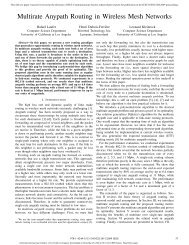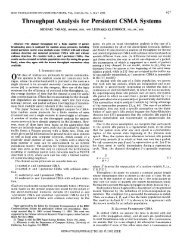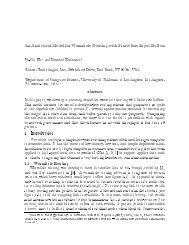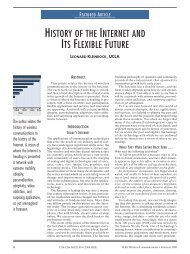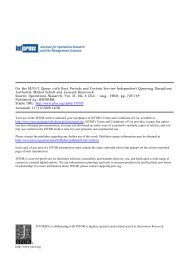On the Capacity of Single-Hop Slotted ALOHA - IEEE Xplore
On the Capacity of Single-Hop Slotted ALOHA - IEEE Xplore
On the Capacity of Single-Hop Slotted ALOHA - IEEE Xplore
You also want an ePaper? Increase the reach of your titles
YUMPU automatically turns print PDFs into web optimized ePapers that Google loves.
984 <strong>IEEE</strong> TRANSACTIONS ON COMMUNICATIONS, VOL. COM-31, 8, AUGUST NO. 1983will transmit in any slot. (This corresponds to <strong>the</strong> <strong>of</strong>fered ference factor I. (In fact, 1 --I is <strong>the</strong> interference encounteredchannel traffic randomized so that slotted <strong>ALOHA</strong> will oper- by a node, and perhaps we should call I <strong>the</strong> noninterferenceate correctly and resolve previous conflicts due to simultane- factor!) We can think <strong>of</strong> this factor as background interferoustransmissions.) In order to compute <strong>the</strong> throughput, we ence. If weassume that <strong>the</strong> interference encountered at anyuse <strong>the</strong> “heavy traffic model,” which corresponds to assuming node is independent <strong>of</strong> <strong>the</strong> number <strong>of</strong> nodes that he hits, <strong>the</strong>nthat all (active) nodes are always busy, but which transmit in- <strong>the</strong> expected throughput for any node in <strong>the</strong> network, ynode,dependently in any given slot depending on this transmission is given byprobability. We denote <strong>the</strong> transmission probability for nodei as pi.nYnode =I x hkYkA. Nodal Throughputk=2Consider an arbitrary node (say node i) in <strong>the</strong> network.The probability that this node correctly transmits a packet tohis partner (say node j ) in any slot is given bywhere hk is <strong>the</strong> probability that a node hits k nodes when hetransmits (note that he always hits himself and his partner).si = Pr {i transmits} Pr { j does not transmit}Pr {none <strong>of</strong> j’s neighbors transmits}where Nj is <strong>the</strong> set <strong>of</strong> nodes that j can hear (excluding hispartner i). The assumption here is that reception is a discreteprocess, i.e., a node ei<strong>the</strong>r hears a transmission or does not.Thus, ano<strong>the</strong>r transmission ei<strong>the</strong>r causes interference or not,depending on whe<strong>the</strong>r he is more distant than <strong>the</strong> threshold<strong>of</strong> reception. In a real network this reception process is notdiscrete but depends on relative power levels, noise, multipath,etc.si is <strong>the</strong> rate at which node i succeeds in sending traffic tohis communication partner. Since we have a single-hop network,this corresponds to <strong>the</strong> throughput for this node, yi.If <strong>the</strong> network were multihop we would have to divide thissuccess rate by <strong>the</strong> path length in order to obtain end-to-endthroughput. Thus, <strong>the</strong> total network throughput y is given byn ny = yi = si.Since <strong>the</strong> networks we consider <strong>the</strong> homogeneous, <strong>the</strong> throughputfor all nodes is identically distributed; <strong>the</strong>refore, we drop<strong>the</strong> subscripts corresponding to <strong>the</strong> particular node underinvestigation, and ra<strong>the</strong>r consider <strong>the</strong> performance <strong>of</strong> a nodethat hits (i.e., interferes with or is heard by) a particular number<strong>of</strong> o<strong>the</strong>r nodes when he transmits. We modify our notationto let Pk be <strong>the</strong> transmission probability <strong>of</strong> a node that hits knodes when he transmits (including himself and his partner)and 7k to represent <strong>the</strong> throughput for a node which hitsk nodes. Making <strong>the</strong> assumption that both nodes <strong>of</strong> a partnershiphit <strong>the</strong> same number <strong>of</strong> nodes (this is not valid, but oursimulations show it to be a reasonable simplifying assumption),or at least that <strong>the</strong>y use <strong>the</strong> same transmission probability,we obtain <strong>the</strong> following expression for <strong>the</strong> throughput:111. THE INTERFERENCE FACTORI is <strong>the</strong> product <strong>of</strong> terms corresponding to <strong>the</strong> interferencegenerated by <strong>the</strong> nodes that are heard by <strong>the</strong> destination. Wecan group <strong>the</strong>se terms depending on <strong>the</strong> number <strong>of</strong> nodes that<strong>the</strong> source <strong>of</strong> <strong>the</strong> interference hits when he transmits. We defineIk to be <strong>the</strong> total interference contribution <strong>of</strong> nodes thathit k nodes when <strong>the</strong>y transmit. Let us call a node that hits ko<strong>the</strong>rs when he transmits a “k-hitter.” Thenn- 2Ik = Pr {a node hears j k-hitters} (1 -pk)’. (5 1j= 0The total interference will <strong>the</strong>n be <strong>the</strong> product <strong>of</strong> <strong>the</strong>se factors.We define Hik to be <strong>the</strong> probability that an arbitrary nodehears j k-hitters. We can evaluate this as follows:n- 2Hik = x Pr {Total <strong>of</strong> 1 k-hitters} Pr {hear j <strong>of</strong> 1)Z=jWe thus have.(;)( ”)j (-- k - 2)”n-2 n-2where we have collected <strong>the</strong> interference terms from nodeso<strong>the</strong>r than <strong>the</strong> node itself and his partner into <strong>the</strong> inter-



